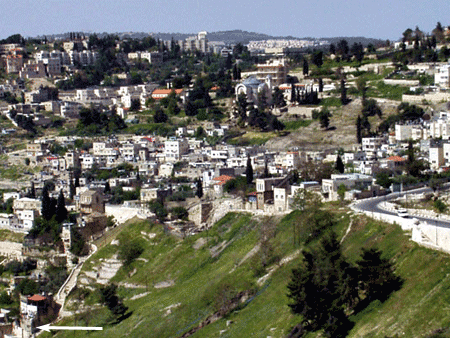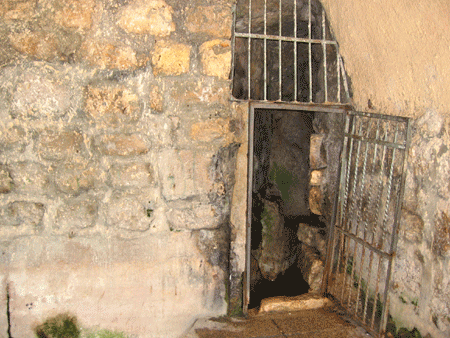|
|
|
 |
|
“THE REST OF THE
HISTORY OF HEZEKIAH, AND ALL HIS MIGHT,
HOW HE CONSTRUCTED THE POOL AND THE CONDUIT
TO BRING WATER INTO THE CITY, IS NOT ALL THIS RECORDED...?"
II KINGS 20: 20
|
|
|
 |
|
 |
| |
| Judean
King Hezekiah was thirty-nine years old when
Sennacherib, King of Assyria, (that is northern Iraq
in our day) invaded Judea in 701 B.C.
Sennacherib captured 46 towns and besieged
Jerusalem. In Sennacherib’s words, “As to
Hezekiah, the Judahite, he did not submit to my
yoke….I made [him] a prisoner in Jerusalem, his
royal residence, like a bird in a cage.” (This
boast is inscribed on a cuneiform prism which
recounts Sennacherib’s Judean military campaign.
It’s on exhibition at the Israel Museum in
Jerusalem.) |
| |
 |
With the super-power
Assyrians threatening his capital and his kingdom,
Hezekiah took action. He consulted the prophet
Isaiah. He attempted an alliance with the
Babylonians, yet built a thick wall to secure
Jerusalem’s newer western neighborhoods. (That
wall, called the “broad wall” can be seen today in
the Jewish Quarter of the Old City.)
And he commissioned his engineers to secure his
water source by building a tunnel to divert the
water from the Gihon spring over to the southwestern
part of the city. The water, then, would be
protected from the enemy and accessible from within
the city. It’s believed that the tunnel could
have been constructed within eight months, with one
shift of tunnelers working by day and another by
night. When Hezekiah’s reign is summarized in
Second Chronicles chapter 32, the tunnel |
|
Photo: Gila Yudkin |
is specifically
highlighted as his greatest |
|
Judean King Hezekiah's Broad Wall |
accomplishment. |
| |
| The
first westerner to describe his exploration of the
tunnel was
Captain Charles Warren, in
October 1867. With a pencil, compass and field
book in his hands, he held a candle for the most
part in his mouth, as he crawled through the tunnel
for four hours with his side-kick Sergeant Birtles
behind him. In some places they had only four
inches of breathing space. (Just for your
information, the water level in
Hezekiah's tunnel today is only knee-high
and it’s a mere 40-minute walk!) |
| |
|
 |
|
Photo: Gila
Yudkin |
|
White arrow points to the
beginning of Hezekiah's Tunnel |
| |
As
meticulous an observer as Warren was, he missed the
inscription chiseled into the rock by Hezekiah’s
engineers, about 20 feet from the end of the tunnel.
That inscription was discovered by accident in June
1880 by a 16-year-old boy named Jacob Eliahu who was
playing hooky from school.
Jacob’s imagination was fired up after learning
about the subterranean conduit carved out by King
Hezekiah. He recruited a fellow student to
explore the tunnel with him. He wasn’t deterred by
rumors that the tunnel was haunted by a genie or
dragon, for since Nehemiah’s day, the spring was
dubbed the Dragon Well. (Nehemiah 2:13)
Jacob and his friend prepared floats with a candle
and matches attached and tied them around their
necks with strings. The plan was for Jacob to
start at the pool of Siloam and for his friend to
start at the Gihon Spring, popularly called the
Virgin’s Fount. Not knowing that his friend at
the other end had finked out and deserted him, Jacob
fearlessly explored the cold and drafty tunnel even
when his candle blew out and his matches were
water-logged.
In total darkness with muddy water up to his chin,
Jacob continued his trek through the tunnel.
He steadied himself by keeping his hand on the damp
stone wall to guide his way. Under his
fingertips he felt the marks of ancient chiseling.
At one point he was certain that he had discovered
an inscription chiseled into the rock. |
| |
|
 |
|
Photo: Gila
Yudkin |
|
Exit of Hezekiah's Tunnel |
| |
| When he
emerged from the tunnel by the Virgin’s Fount, the
Siloam village women who were filling their jars
with water shrieked and cursed, for they thought he
was a genie. Jacob ran for his life back to
school and breathlessly told the headmaster about
his escapade. His report of discovering an
inscription in the Siloam tunnel caused quite a
sensation in the school. |
| |
Walk the Temple Mount with Abraham and
Isaac, David and Solomon, Jesus and the
disciples, Mohammed and the angel Gabriel
with
Gila's
Temple Mount audio tour on a
CD.
Gila's Temple Mount tour
is now also available as a written
24-page PDF with a
Temple Mount plan,
guidelines for passing the security check
and ten recommended reads on the
Temple Mount from Gila's bookshelves.
|
Word about the discovery spread quickly around
Jerusalem. An enterprising vandal
surreptitiously removed the inscription from the
rock and sold it to a Greek antiquities dealer.
The Ottoman Turks who then were ruling Palestine
confiscated the inscription and brought it to the
Museum of the Ancient Orient in Istanbul where it is
to the present day, in a locked room on an upper
floor and not accessible to the public.
A translation of the inscription which was written
in the ancient Hebrew alphabet was first published
by the Palestine Exploration Fund Quarterly
Statement in July 1881. Here is a modern
translation: |
| |
“This is the story of the boring through.
While [the tunnelers lifted] the pick-axe each
toward his fellow and while three cubits [remained
yet] to be bored [through, there was heard] the
voice of a man calling his fellow – for there was
a split [or crack or overlap] in the rock on the
right hand. When the tunnel was driven through,
the tunnelers hewed the rock, each man toward his
fellow, pick-axe against pick-axe. And the
water flowed from the spring toward the reservoir
for twelve hundred cubits. The height of the
rock above the head of the tunnelers was a hundred
cubits.”
|
| |
| On a visit
to Istanbul in June 1998, I was determined
to see the Siloam Inscription. The museum
guards told me it was located in an upper
room “closed for renovations.” I found that
a generous offering of baksheesh ($$)
facilitated opening the locked room. I
was not only able to see the inscription,
but also to
put my hands on it – and
photograph it as well. (Baksheesh, the
oil that keeps everything running smoothly
here in the Middle East, is a legacy from
the Ottoman Turks.) |
|
 |
|
Photo:
Gila Yudkin |
|
Siloam Inscription
describes the meeting of the 2 teams of
tunnelers |
| |
It’s not yet
possible to view the Siloam inscription in
Jerusalem, but perhaps it will be, by the
time of your next pilgrimage. The President
of Israel, Shimon Peres, during his November
2007 state visit to Istanbul, asked the
Turks to return the inscription to its home
in Jerusalem. Rumor has it that the
Turks are considering this request and may
“loan” the inscription to Jerusalem as a way
of participating in Israel’s 60th birthday
celebrations this year.
The inscription would be a great place to
honor King Hezekiah and his engineers.
And we can discuss all the various theories
of how the crews actually did manage to meet
up. Was it a crack or an overlap or a
subterranean stream or soft rock or a
mathematical formula or pure luck?
Or was it divine providence??? |
| |
|
Copyright 2008, 2010 Gila Yudkin. Permission
needed for any reuse. |
| |
|
Gila
Yudkin, a Connecticut Yankee
guiding in King David’s court, is looking
forward to showing you the Siloam
inscription when it arrives in Jerusalem.
In the meantime, she’d be happy to splash
with you through Hezekiah’s Tunnel and show
you Warren’s Shaft as well as many of
Jerusalem’s other ancient treasures.
Be sure to
contact her in the beginning
stages of planning your tour to check her
availability. |
| |
|
Postscript My long-time friend Curtis
Manor from Searcy, Arkansas gave me the tip
of how to put my hands on the ancient Siloam
inscription not "open to the public" in
Istanbul. Here is his most memorable
experience of leading a group through
Hezekiah's Tunnel:
"In 1979 I reluctantly took a stubborn
90-year-old woman through the tunnel, and
she almost gave out about half-way through.
My partner, who happened to be walking right
in front of her, tried to steady her, but,
the passage being too narrow either to walk
beside her and steady her or pick her up and
carry her, had to walk backward, holding her
by both hands, as we all moved at a crawling
pace, all the rest of the wade!
Meanwhile, Nell and I were guiding a blind
couple through the channel--although we
really didn't need to. The darkness
didn't slow them down at all!
The whole crowd had a jolly time talking
about it for the rest of the tour, and
decided we had probably set an all-time
one-of-a-kind record for wacky
accomplishments in Hezekiah's tunnel.
We figured that, in fact, we may have set
three: (1) Oldest person to walk through it,
(2) first blind couple to walk through it,
and (3) first person to walk through it
backwards!" |
| |
The first Connecticut Yankee to leave
gigantic footprints behind in the Holy Land
was
Edward Robinson.
Read more about
Captain Charles Warren,
nicknamed the "intrepid mole" who explored
underground Jerusalem from 1867 to 1870.
Water flowing through Hezekiah’s Tunnel
spilled into the
Pool of Siloam
which is mentioned in John chapter 9.
Read Gila’s highlight about the twenty-first
century discovery of the 2,000-year-old pool
in “Let’s wash in the Pool of Siloam.”
If you are contemplating leading a tour to
the Holy Land or know someone who is, don’t
miss Gila’s tips about baksheesh and other
matters guaranteed to make your Holy Land
pilgrimage a rave success. Read
Tips from A to Z for Holy
Land Tour Leaders. |
| |
| Read about
another accidental archeological
discovery -- at
Armageddon. |
|
|
|
GILA
YUDKIN
•
TCHERNIKOVSKI
64A
•
JERUSALEM
•
ISRAEL
gila@itsgila.com
HOME
•
BOOK
GILA
•
TIPS
FOR TOURS •
ABOUT GILA
|
|

